Don't wanna be here? Send us removal request.
Text
What is TikTok?!
Social media has grown significantly as a part of our daily life. It keeps us connected yet tethered to perpetually troubling ideas circulating online. TikTok, created in 2016, is a social media app with over 1 billion users monthly. It quickly rose to popularity amongst younger generations during the Covid-19 pandemic. When you download TikTok, it collects data about your location, gender, and age (Dias and Jeanavive, 2021). Then, when you first open the app, you are greeted with tons of short-form content to keep your attention span, with built-in features where people can search, send, and share videos. The page has a following section, “ForYou Page” (FYP), and a TikTok shop. When creating content, you are met with filters for your background, video, and voice. As soon as you watch these videos, you start to allow the app's algorithm to determine who you are and how to push videos so you continue to stay on the app. Like any other social media, TikTok goes through waves of various trends. In our series of posts, we will discuss the multiple ways the app and its features garner misogynistic actions and thoughts, the sexualization of young girls, and unrealistic beauty standards.
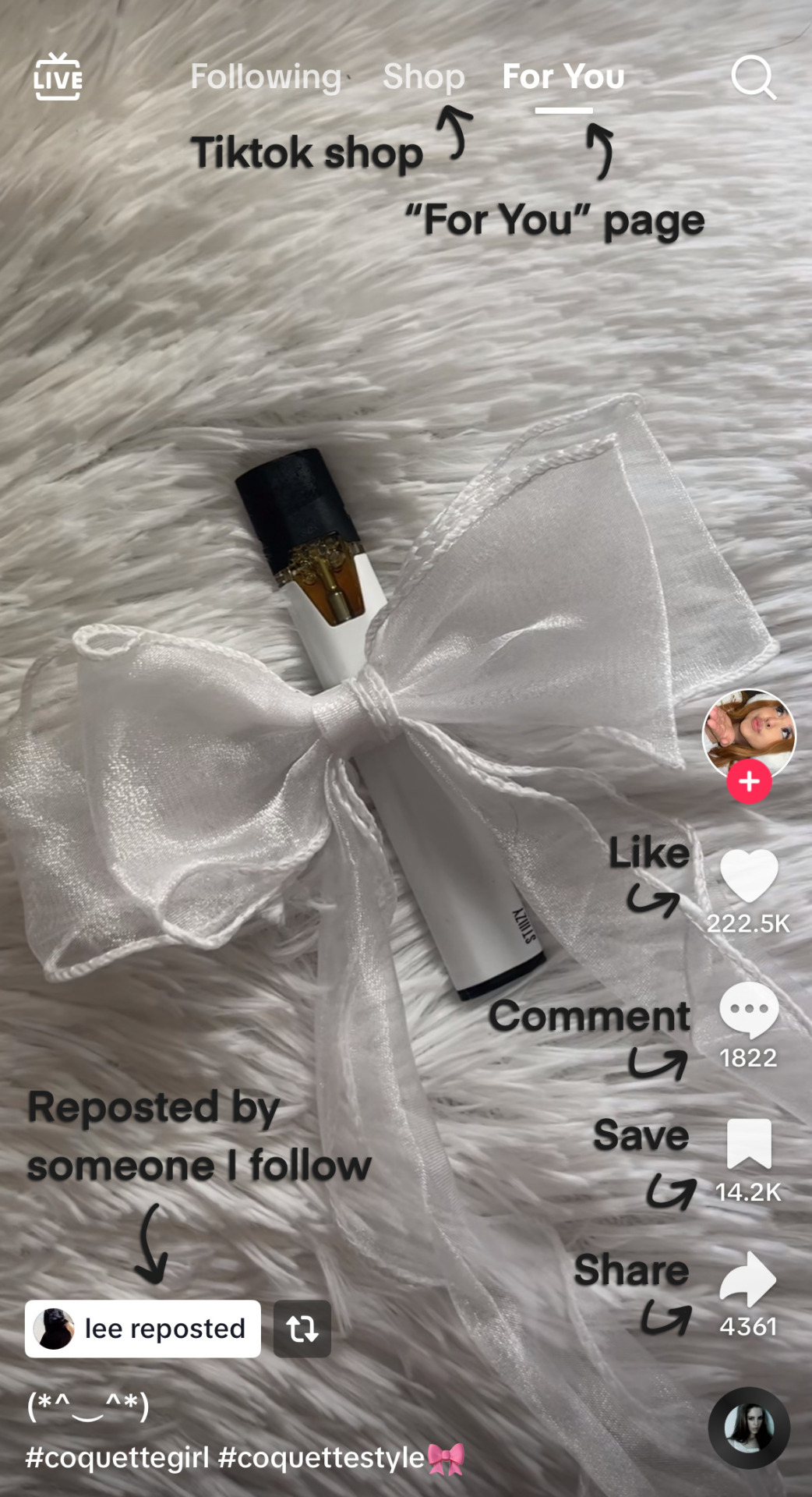
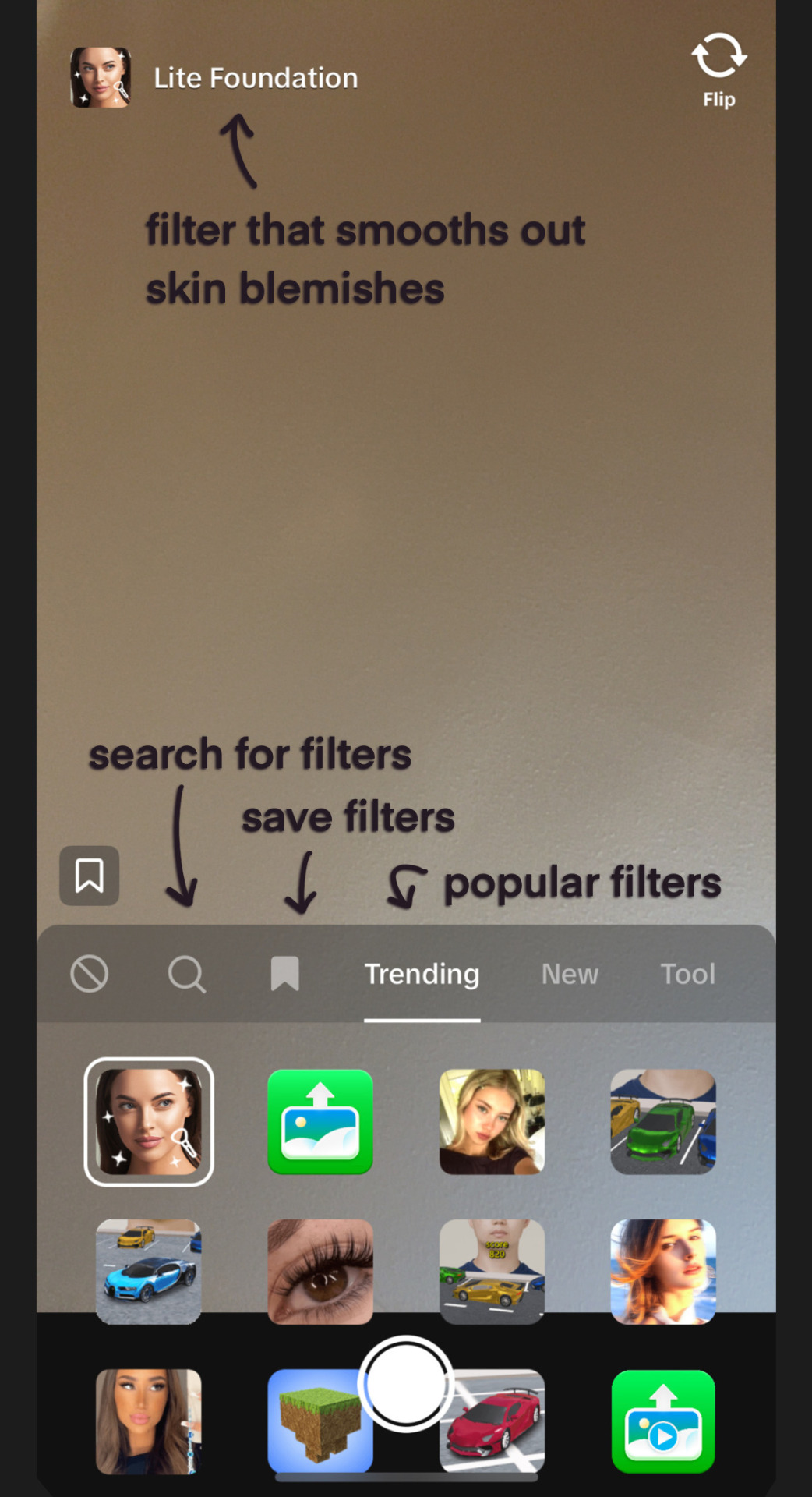
SOURCES
(^‿^) (@xoxoazuzena) Tiktok, December 6th, 2023. https://www.tiktok.com/t/ZT8a3wsrV/
Dias, Avani, Jeanavive McGregor and Lauren Day. “The Dark Side of TikTok’s Algorithm: Beyond the Dances and Skits There’s a Darker Side to TikTok. The App’s Algorithm Is Exposing Users to Dangerous Content While Controlling Which People and Political Movements Get Attention.” ABC News, July 26, 2021. https://www.abc.net.au/news/2021-07-26/tiktok-algorithm-
#Tiktok#Social media#gender roles#gender ideology#trends#filters#beauty standards#short-form content#Why are there so many ___-girls
0 notes
Text
TikTok’s Algorithm
TikTok’s Algorithm and How it Works.
Like many other social media applications, TikTok uses an intricate algorithm to determine what videos and ads to push to a person's account. Unlike other platforms, you do not have to follow any of these influencers for their content to appear on your feed. The algorithm works based on likes, shares, saves, and comments. Although the people you follow can influence the content that appears, you do not need to follow someone to get their videos on your “ForYouPage.” (FYP). Another aspect considered when TikTok determines what is pushed out to a person is how long a person watches a video. The longer a person watches a type of content, the more it will appear, furthering its vacuum (Dias and Jeanavive, 2021). All these aspects of an algorithm combined steer a consumer down a certain content rabbit hole.
A person can become a “micro-target” for certain content within a few hours, creating an “echo-chamber” of various values and beliefs. While it may not always be harmful, it can promote dangerous content and ideas into young people's minds. TikTok has been found to influence users' social, sexual, and cultural identities and can influence people to want to change themselves based on their “ForYouPage” (Dias and Jeanavive, 2021), so if your feed is full of videos on the same idea, from the same person, or the same topic reposted repeatedly by different people, it’s not surprising that the person may conform to these videos. When such a powerful algorithm is combined with young, impressionable minds, it becomes extremely easy to influence them and mold them into a person that aligns with toxic traits, gender roles, and sexist behavior.
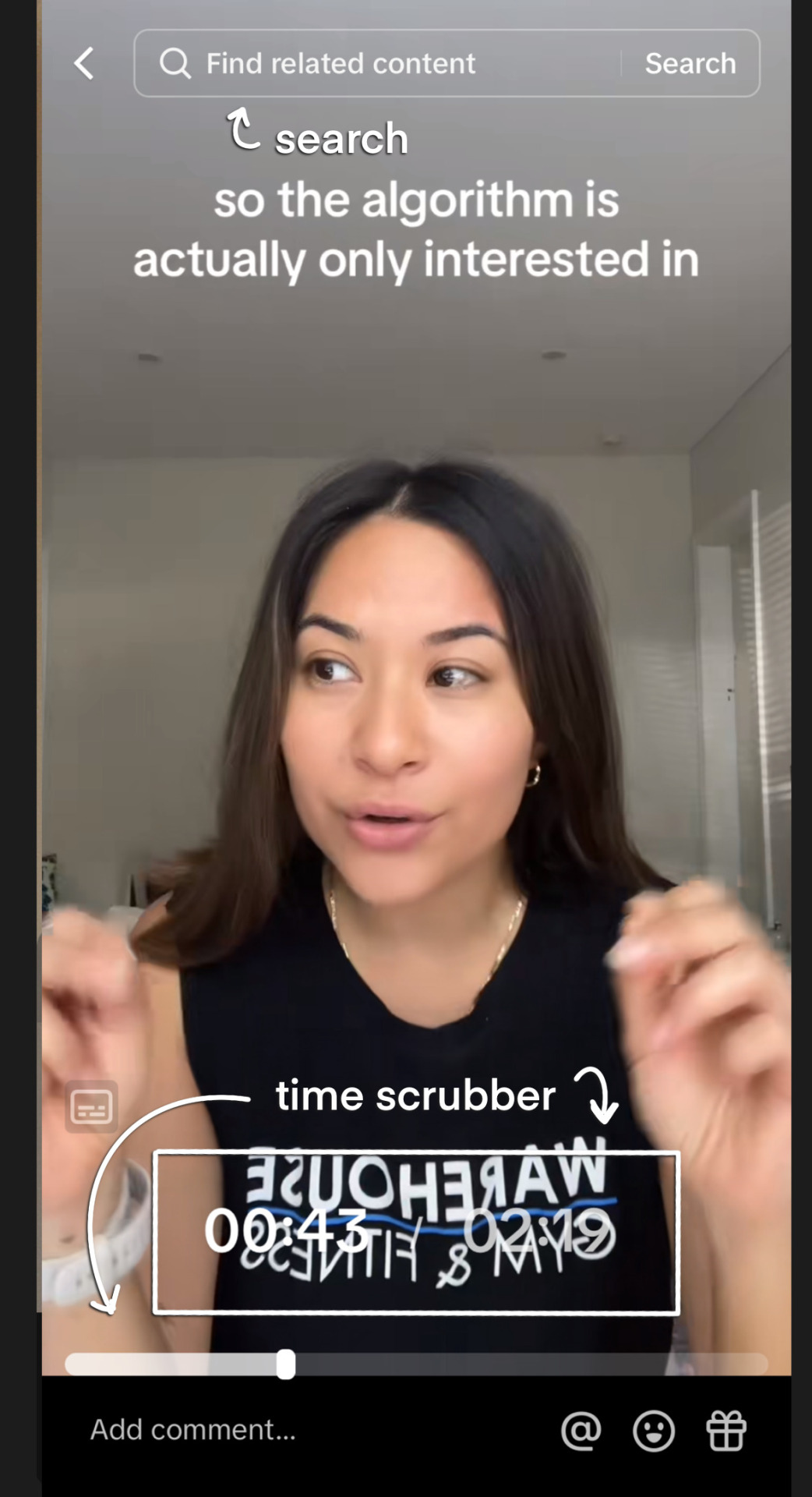
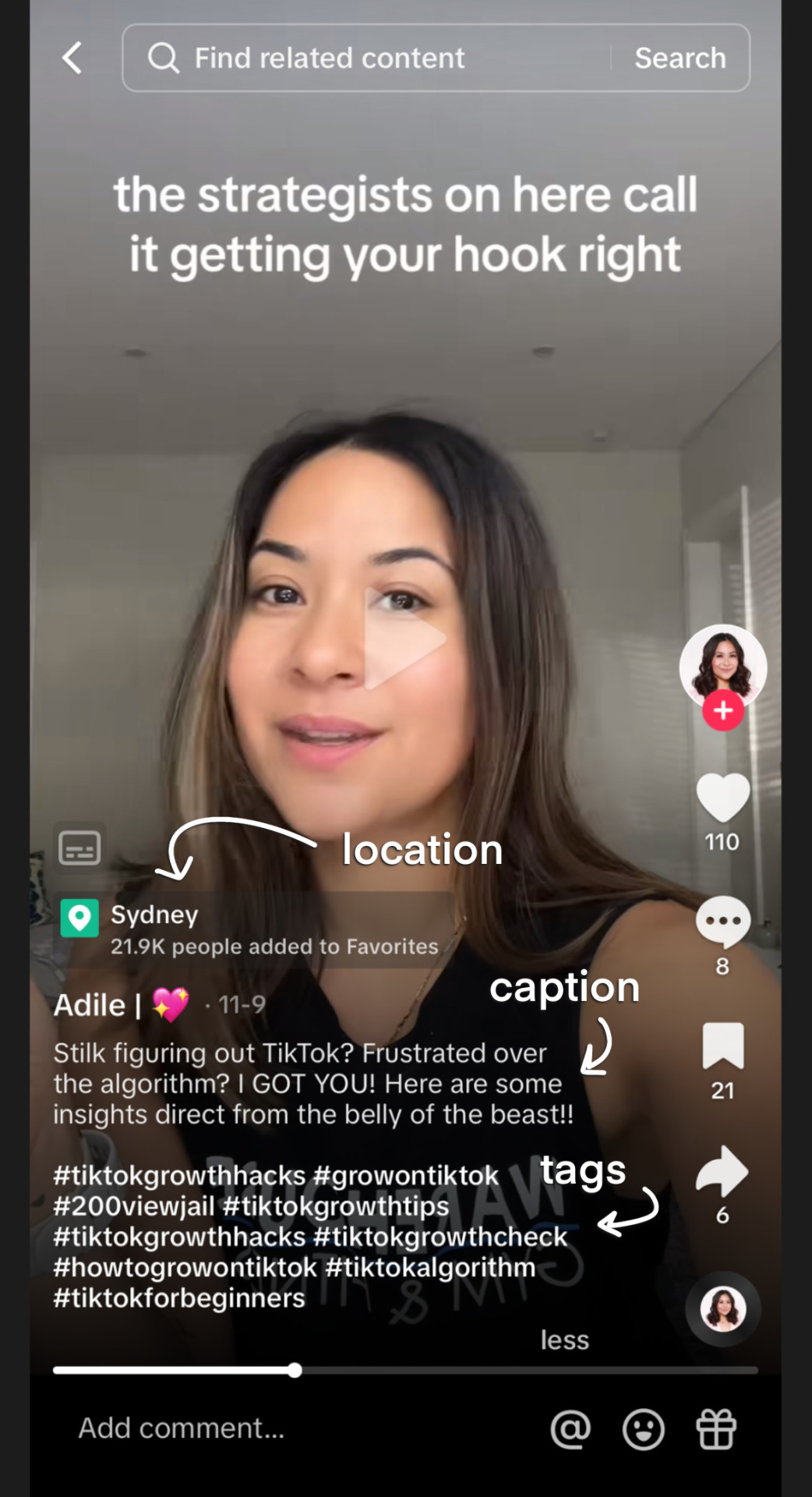
How the Algorithm can influence Behaviors and Ideas
Many different kinds of videos can be found on TikTok, and not all of them are concerning. That said, gender stereotypes are perpetuated within many TikTok videos and trends. Chapter two of Gendered Lives talks about how gender roles are social constructs that are learned during childhood and everyday experience (Kirk and Okazawa-Rey, 2020). These traditional roles can be harmful because it encourages men to be violent while at the same time telling women to be docile and to endure abuse (Allan G. Johnson). A theme in the essay Gender , Migration, and Exlie which can be found in Gendered Lives it discusses how throughout the world gender roles can be attributed to the reason why gender related violence is unreported (Kirk and Okazawa-Rey, 2020). When people watch videos on TikTok that have gender roles, it can cause an unconscious bias. This bias may appear as they interact with family, friends, classmates, and coworkers. Gender roles can appear through subtle trends and videos, demeaning jokes, or explicit videos that detail what a person should act like.
SOURCES
Dias, Avani, Jeanavive McGregor and Lauren Day. “The Dark Side of TikTok’s Algorithm: Beyond the Dances and Skits There’s a Darker Side to TikTok. The App’s Algorithm Is Exposing Users to Dangerous Content While Controlling Which People and Political Movements Get Attention.” ABC News, July 26, 2021. https://www.abc.net.au/news/2021-07-26/tiktok-algorithm-dangerous-eating-disorder-content-censorship/100277134.
Johnson, Allan G. “Patriarchy, the System: An It, Not a He, a Them, or an Us’ (1997)," in Gwyn Kirk & Margo Okazawa-Rey. “Gendered Lives: International Perspectives” New York: Oxford University Press, 2020.
Freedman, Jane, Zeynep Kivilcim and Nurcan Özgür Baklacioğlu. 'Gender, Migration and Exile (2017), in Gwyn Kirk & Margo Okazawa-Rey. “Gendered Lives: International Perspectives.” New York: Oxford University Press, 2020.
0 notes
Text
The Algorithm's Effect on Users

How Does The Algorithm Engage with Users?
In the Gendered Lives reading “Media Representations and the Creation of Knowledge,” Kirk and Okazawa-Rey write briefly about the role of social media in news circulation and how it works. They state, “As a condition of using such sites, these companies have unprecedented access to our personal information to direct specific advertising our way. Moreover, online business models that seek to maximize ‘clicks’ to earn advertising revenue encourage posting information that is ‘click-worthy’ regardless of whether it is accurate” (Kirk and Okazawa-Rey, 2020). In other words, a common method used by advertisers and social media users to gain more interaction with their content is to appeal to the need for belief affirmation and curiosity.
Algorithms used by TikTok and other social media platforms filter the content presented to each user so that they are not presented with views or news that challenge their personal beliefs, essentially submerging them into an online sphere of constant positive feedback for every opinion or experience they have. This presents a degrading effect on media literacy. If one is presented with a post that agrees with their values or beliefs, they are less likely to question it. If you like pineapple on pizza, and you see someone else on TikTok who claims that pineapple is the best possible topping for pizza, then you aren’t going to question that post because you already believe it to be true.
This effect is helped by the fact that people often get their news from accounts that post about the news, and these accounts are more prone to posting with biases since they do not operate the same way as newspapers or newscasters. The same level of fact-checking or extensive research simply doesn’t exist with a platform where it’s so easy to post and repost, which leads to the rapid spread of misinformation and biases. TikTok is also somewhat infamous for its young user base, consisting largely of teens and adults under 30, even children younger than their teens if given access to a device. Young and impressionable minds will be the most affected by biases they take in from TikTok because they don’t have the maturity, critical thought, or media literacy to see that the content they are fed might be subverting their thinking. Instead of learning how to think about real-world events and other people from their education and community, they’re learning through an algorithm. So, when presented with information or ideas that may be false or negatively reflected on a group of people, users will absorb it without question. That absorption may come in reposting, liking, or scrolling through and ignoring the post.
How Does The Algorithm Warp Users’ Sense of Self & Others?
A small social science review paper about how the algorithm of TikTok functions in shaping users’ identities discusses in more detail how people find themselves trapped in a cycle of repeatedly feeding about, by, and for the same groups. The authors write, “Due to the opaqueness or “black box-ed” nature of algorithms, users experience them just through their perceptions. Because what people see on social media is largely personalized, it shapes how people see themselves and others (Bhandari and Bimo 2022) but also impacts their behavior on social media platforms (DeVito 2021)” (Ionescu & Licu, 2023). This means that not thinking critically about the information they are seeing means that users are taking in opinions without considering alternate perspectives. Learning hatred without empathy means these users, in their filter bubbles, will continue to perpetuate hatred.
In their research, Ionescu and Licu also talk about how these “filter bubbles” create what’s called a crystal framework, where “The main characteristics of the “crystal” were: reflective (parts of their self-concept were reflected back to them in the feed); multifaceted; has a refinement strategy; is diffractive” (Ionescu & Licu, 2023). When placed into filter bubbles, users are put into the net of fellow users who share the ideologies and opinions of others, meaning that they are constantly surrounded by others who think, act, and look the same as them. This can snowball into a sort of ‘us vs.. them’ mentality on social media platforms, as users engage with others of a like mind (a like mind which the platform’s algorithm has also curated), they will gradually take in opinions and potential hatred of other groups who hold differing opinions, without taking the chance to think critically about what they are seeing of those groups.
When young users are put into one of these filter bubbles where all they see is a continuous stream of derogatory and discriminatory content, it normalizes the attitudes and language of misogyny. It generates a misogynistic worldview that the mind takes on.
How Do We See “Filter Bubbles” and Internalized Hatred Manifesting?
How this influx of filtered content shapes how users see themselves in relation to others can manifest in the form of online harassment. Misogynists and others with similar beliefs, when presented with content contending a more feminist perspective, will lash out because they may feel that their sense of identity and the way they see the world is being attacked. In a research survey conducted by the Pew Research Center on online harassment, it was found that the overall amount of online harassment has increased since 2017, stating, “Beyond politics, more also cite their gender or their racial and ethnic background as reasons why they believe they were harassed online” (Vogels, 2021).

As shown in the data, the cases of online harassment have shown a notable increase since 2017. We cannot say for certain, but it may not be unwise to rule out TikTok’s notoriously addictive algorithm as playing a part in this increase, as the platform was released in September 2016. It is also worth noting that the amount of harassment faced by users varies depending on their race, with Black and Hispanic users saying they often find themselves harassed due to their race (Vogels, 2021). This indicates that the backlash faced by women on TikTok is not only gendered but also racial. The research article also states that “50% of lesbian, gay or bisexual adults who have been harassed online say they think it occurred because of their sexual orientation” (Vogels, 2021). The takeaway here is that these trends and the way they generalize women result in more persecution targeting minority groups of women.
We find that through the perpetuation of misogyny, racism, homophobia, and transphobia in these filter bubbles, online spaces are made more dangerous to individuals belonging to minority groups.
How Does This Relate to a Watered-Down and Dehumanizing Image of Women?
Trends such as the girl math versus boy math and Roman empire trends are made general to garner as large of an audience as possible. While there may be a target audience for these trends, they will inevitably gain the attention of users who may not relate to the experiences or find them distasteful. This means that trends meant to be somewhat silly and uniquely catered to women with specific experiences may suddenly find themselves being co-opted by people with deep internalized prejudices to make it into something hateful or degrading. We can watch these trends devolve into another way to simply accuse women of being too unintelligent, too childish, too one-minded, fit only for sex & reproduction & motherhood, and simply not human enough to garner the respect of men.
Trends that gain a lot of attention on TikTok are used as a tool by and for misogynists to reaffirm what they already believe, that “modern” women are impudent and dismissive. Algorithms ensnare people into hateful and sexist communities that teach them how to twist every aspect of a woman to fit their mold of what a woman should be. They then go out into other parts of social media to take trends and content posted by women and either harass them for it or take the trend and turn it into a narrative demeaning women.
SOURCES
Ionescu, Claudiu Gabriel, and Monica Licu. "Are TikTok Algorithms Influencing Users’ Self-Perceived Identities and Personal Values? A Mini Review" Social Sciences 12, no. 8: 465. May 30, 2023. https://doi.org/10.3390/socsci12080465
Kirk, Gwyn & Margo Okazawa-Rey. “Gendered Lives: International Perspectives.” New York: Oxford University Press, 2020.
Vogels, Emily A. “The State of Online Harassment.” Pew Research Center: Internet, Science & Tech, January 13, 2021.
#Tiktok#Ruby#Filter Bubbles#algorithm#How does it affect brains?#Users#doomscrolling#my videos on tiktok are all the same content is it because of this?#yes it is
0 notes
Text
TikTok Trends and Their Influence on Young Minds
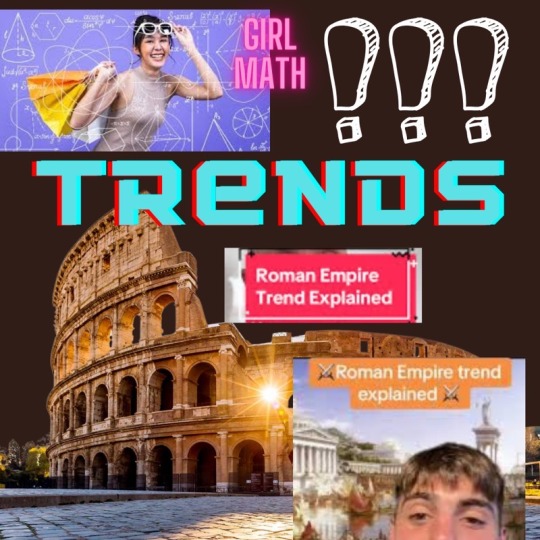
When analyzing how TikTok as a platform perpetuates sexism, it is important to look at its many trends. A trend is an idea many people base their TikToks on, usually accompanied by a video, song, filter, or sound effect. Trends are vital to TikTok as they connect users, allow them to provide their opinions, and use the trend as a basis. While not all trends are sexist, many trends have some basis in sexism and they do so in different ways at different levels. Some trends, such as the “Alpha Male'' and “Trad Wife'' trends, set out to express opinions and promote gender norms, while others, such as the “Girl Math” or “Pigtail Theory” trends, began without any sexist intent but resulted in being interpreted that way.
The “Roman Empire” trend began in August 2023, when women would ask their male friends, boyfriends, and husbands how often they thought about the Roman Empire. The consensus of the trend was that men think about the Roman Empire extremely often, even as often as every week (B, 2023). Men asked the question would try to explain to the women that it’s normal for them to think about the Roman Empire this often (Dennehy, 2023). In an analysis of the trend, Time Magazine states, “Based on their answers, if you haven’t been thinking about the Roman Empire as frequently as every day or at least three to four times a month, you're doing it wrong” (Mendez II, 2023). While most were likely not serious, this trend pushed the stereotype of the connection between men with war and violence, as only men were asked the question. It subconsciously connects violence with masculinity for both men and women watching this trend. More importantly, the trend implies that men should consider this subject extremely often. As TikTok’s user base is generally young and impressionable, trends like these pose a significant threat and can spread damaging ideas.
TikToks from @ambarrail @laurendennehy Top to bottom
Branching off from the Roman Empire trend, women on TikTok began to ask themselves what the female equivalent to the Roman Empire trend was. Women began wondering what they thought about on a weekly or daily basis, similar to the Roman Empire. Answers varied heavily, ranging from celebrities to people from their pasts, yet the most common answer was shocking to men. A vast majority of women said that their “Roman Empire” was their fear of being sexually assaulted and murdered, typically thinking about it every time they went outside, especially at night (ellenrethwisch, 2023). While this may have surprised some, most women agreed that they, too, feared what could happen to them if they were alone walking to their car or past men.
TikTok from @ellenrethwisch
TikTok from @avidamerican2.0
Tiktok from @society97pod
Similar to the original Roman Empire trend, the “Alpha Male” trend also encourages unhealthy values and beliefs in younger men. The trend mainly revolves around influencers on social media platforms (especially TikTok), such as Andrew Tate and Joe Rogan, who frequently state their opinions about manhood. The term “Alpha Male” describes a dominant man who sits on top of the social hierarchy. These influencers who regard themselves as “Alpha Males” all place importance and value of a man’s life on money and physical fitness, claiming that men without these things are worthless and these things should be their primary goals. They also state dangerous sexist and homophobic ideas, including that women are naturally inferior to men and do not have a capacity for greatness like men do. These beliefs stem from traditional gender norms but are even more extreme as often these “Alpha Males” will urge viewers to stay away from women and only use them for sex (Bureau, 2022). This trend has received an overwhelming amount of following and is having a noticeable effect on men, who agree with the words of these influencers and either believe themselves to be worthless or put down others who they see as “broke” or weak, as well as promoting misogynistic and homophobic ideas.
TikTok from @thebureauof
The “Trad Wife” trend advertises similar values to women. The term “Trad Wife” is short for “traditional wife,” the trend encourages women to be housewives and serve their husbands rather than work. The “traditional wife” is inspired by 1950s-era housewives, and the trend participants often wear 1950s-inspired clothes. The trend prominently promotes traditional gender roles to women. Some argue that the trend is harmless as people should have the choice to live in whatever way they want, yet some argue that, like the “Alpha Male” trend, it tells women that their purpose in life is to cook, clean, and serve the men in their lives.
TikTok from @mrsarialewis
TikTok from @themakingofelrodranch
TikTok from @esteecwilliams
The “Girl Math” trend began around the same time as the Roman Empire trend and was similar as the intended contributors to the trend were women. The trend began as a joke by women about various decisions they make in their daily lives that they claim to make sense yet make little sense, such as spending extra money to receive free shipping (Ippolito, 2023). The trend began simply as a joke among women with no sexist implications. Unfortunately, while these posts were made with a joking and entertaining intent, many people took it very seriously. Trends like these further fortify the concept of “you ___ like a girl.” In an article about this trend, CNN states, “Groups of people started criticizing these innocent jokes, as if a single quip about the mysterious desire for free shipping indicates deep financial illiteracy or that the circuitous logic women admit to very occasionally using affects every serious decision of their lives” (Willingham, 2023). Even though there was no underlying meaning or sexist implications by the creators and contributors of this trend, many interpreted this trend as a confirmation by women that they were not as financially intelligent as men.
TikTok from @daveandjanie
Finally, the “Pigtail Theory” trend, which began around January 2023, was a trend where women working as waitresses or other service positions claimed that wearing their hair in pigtails would noticeably increase the money they received as tips from men (tiktok source). The trend spread fast, and hundreds of women were testing it out, most of whom claimed to see an increase in tips. The general belief behind the “pigtail theory” is that pigtails make women look younger; therefore, men find younger women attractive. While not much can be determined about the legitimacy of these tests, this trend is spreading the belief to thousands of women that men are more attracted to younger-appearing women, as well as accusing these men of being gross and disturbing for finding younger women attractive.
Tiktok from @crazysanya2.0
TikTok trends are a recent phenomenon that has provided methods of spreading information and opinions to substantial numbers of people faster than ever. The consequence is that it allows stereotypes and beliefs to be spread to young and impressionable audiences, who will often not look deeper into the content they are seeing. As Gendered Lives puts it, “This may be done deliberately or inadvertently but always has the effect of misleading readers about the facts of an issue” (Kirk & Okazawa-Rey, 2020). It also allows for misinterpretation, where viewers will use trends to perpetuate stereotypes even when they were never there, as demonstrated by the “Girl Math” trend. Overall, TikTok is an incredible source of receiving and transmitting information, but it is imperative to check the motivation and legitimacy behind what you see.
SOURCES
Aria (@mrsarialewis). TikTok, October 24, 2023. https://www.tiktok.com/@mrsarialewis/video/7293517273497619754?q=trad%20wife&t=1702337285863
AvidAmerican2.0 (@AvidAmerican2.0). Tiktok, November 1, 2023. https://www.tiktok.com/@avidamerican2.0/video/7296535586871987499?q=girl%20roman%20empire%20murder&t=1702318873701
B, Alexia (@ambarrail). Tiktok, September 14, 2023. https://www.tiktok.com/@ambarrail/video/7278682791531908398?_r=1&_t=8fifkURBY8Q
Bureau, The (@thebureauof). Tiktok, September 10, 2022. https://www.tiktok.com/@thebureauof/video/7141956850823499054?q=andrew%20tate&t=1702261908758
Dennehy, Lauren (@laurendennehy). Tiktok, September 17, 2023. https://www.tiktok.com/t/ZT8mRmRe5/
ellenrethwisch (@ellenrethwisch). Tiktok, September 15, 2023. https://www.tiktok.com/@ellenrethwisch/video/7279145303167618346?q=girl%20roman%20empire%20murder&t=1702318873701
Estee (@esteecwilliams). TikTok, March 19, 2023. https://www.tiktok.com/@esteecwilliams/video/7212409045460798762?_r=1&_t=8i7CB7qb4o7
Ippolito, Janie (@daveandjanie). Tiktok, September 25, 2023. https://www.tiktok.com/@daveandjanie/video/7282903880747306283?is_from_webapp=1&web_id=7309634021867882026
Kirk, Gwyn, and Margo Okazawa-Rey. “Media Representations and the Creation of Knowledge.”
Gendered Lives: Intersectional Perspectives, Oxford University Press, New York, 2020, pp. 52–56.
Mendez II, Moises. “The Tiktok Roman Empire Trend, Explained.” Time, 15 Sept. 2023, time.com/6314544/tiktok-roman-empire-trend/.
sanya👣 (@crazysanya2.0). Tiktok, May 27, 2023. https://www.tiktok.com/@crazysanya2.0/video/7237901085569092910 is_from_webapp=1&sender_device=pc&web_id=7309634021867882026 – Pigtail Theory
Society 97 (@society97pod). Tiktok, September 22, 2023. https://www.tiktok.com/@society97pod/video/7281731368793640238?q=girl%20woman%20empire%20murder&t=1702319050116
Tyler & Sarah (@themakingofelrodranch). TikTok, January 13, 2023. https://www.tiktok.com/@themakingofelrodranch/video/7188246209910394155?q=trad%20wife&t=1702337285863
Willingham, AJ. “‘Girl Math’ Was a Fun Social Media Joke. Then It Got Complicated.” CNN, Cable News Network, 7 Oct. 2023, www.cnn.com/2023/10/07/us/girl-math-boy-social-media-cec/index.html.
#Tiktok#Henry#Pigtail trend#hair theory#Girl math#math#why is it girl math and not just math?#boy math#Roman empire#murder#Women#Gender roles#Being out at night as a woman is scary#Trad wife#traditional femininity#alpha male
0 notes
Text
How Filters Promote Western Beauty Standards

When making a TikTok, the app has around 400 filters to pick from. A filter is a photo effect that is applied to images or videos that alter how you look, sound, or even the background. These filters allow one to choose exactly what appearance you want to show the online world. Maybe you choose the “natural” filter, which lightens your skin tone, reddens your lips, and widens your eyes. This filter gives users the subconscious correlation between European features and the term “natural.” The “natural” filter is one of many filters that whitens users’ skin tone and subjects girls to Western beauty standards. Filters will have labels such as “cyber glasses” that give the user glasses but also lighten skin tones or make your chin thinner. This is a dangerous trend because the labels on the filters are misleading. Subtly altering users' facial structure, pigment, and other characteristics without indicating to the user that the changes are in effect creates a dysmorphic aspect. If you type in “beauty filters” to the TikTok search engine, you will find that the filters cater to women. Very few filters change men's appearance to fit a standard. The filters catered to men are drastic, and you can see that a filter is in effect, which takes away some of the psychological manipulation that comes with the subtle alterations on feminine filters.
In some countries, such as Japan, the app has new updates where you are taken straight to a filter upon opening the app. This said filter follows a similar pattern discussed above but is drastically intensified.
Tiktok from @looksbylexington
The example above is a woman who posted about the built-in filter feature on the Japanese side of TikTok. As you can see, many features on the woman’s face were altered to fit a specific beauty standard. The fact that this is the automatic preset encourages users to use the filter and also perpetuates the notion that these features are normal. Within our course we expanded our idea of beauty beyond simply Westernized standards. It’s important to think about the way other cultures' beauty standards affect ours as well as how Western standards affect theirs. In a Transnational Beauty Circuits: Asian American Women, Technology, and Circle Contact Lenses a reading in the textbook Gendered Lives, the topic of Westernized beauty standards for Asian women is discussed.
---- “Asian American studies professor Linda Trinh Vō analyzes Asian and Asian American women’s use of circle contact lenses that retailers claim will make the wearer’s eyes appear ‘gorgeous, luminous, bigger, sexier, and more alluring.’ Young women promote these lenses online by posting how-to videos, dispensing beauty advice, and garnering commercial endorsements. Vō sees transnational online circuits as repositioning young Asian American women in setting beauty trends, in contrast to how corporate America positions them as outside societal beauty norms” (Kirk and Okazawa-Rey, 2020).
TikTok plays into this by commercializing with its new sales feature. When the app first came out, there were only two tabs on the app home screen: a “following” tab where you could watch the videos of people you chose to follow and a “for you page” where the app customized an endless collection of videos based on the content you engaged with. Nowadays, a new tab has been added called “shop.” This enables brands to partner up with content creators to advertise products. The app takes you to the product website with one click on the video. This increased marketing also means increased product sales to women meant to “enhance” or alter appearances. The Pakistan Journal of Humanities and Social Sciences references this phenomenon.
-----“The cosmetic and media industry spent millions of dollars to showcase the ideal feminine body to promote their products worldwide. Social media and traditional cultural factors, created a socio-digital construct in which the ideal attractive woman embodies European features consisting of fox eyes, big lips, a petite frame with curves, fair skin, and lush straight hair. This reconstructed ideal image was promoted so excessively that women began to trade their authentic selves for “reel” bodies that represented what they wanted to be” (Hafeez, 2023).
This is an incredibly convenient marketing tool and encourages advertisement by content creators. Advertisement on TikTok is partially successful due to users' time on the app. Even the name of the app, “TikTok,” relates to the time consumption that the app causes. The stream of media is constant. You can never reach the bottom of the content page because there is none. You are also consuming content that is either packed down into 15-second clips or 3-minute-long chunks where the objective is to keep the user's attention. Creators utilize these tactics that have stimulating effects and, as a result, contribute to the addictive quality of the app. This addictive consumerism upholds and cements cultural constructs and beauty standards by spamming images, slogans, and videos of creators who are paid to promote beauty standards.
Nowadays, influencers can post with subtle filters without the app telling its users that a filter is present. This creates unrealistic standards for fans and followers of influencers, who compare themselves to the filtered version of their celebrities without realizing it is a filter. Gendered Lives discusses this in Chapter 5 titled Bodies, Health, and Wellness, stating, “To the extent that women or female-identified people internalize ideal beauty standards, we set ourselves up to pursue a goal that is largely unattainable” (Kirk and Okazawa-Rey, 2020).
Often, because of this impossible, unattainable visual goal, women resort to using filters themselves, adding to the synthetic, cyclical standard for women worldwide. A standard that TikTok plays a large part in due to the sheer size of the app and its presence globally. Overall, TikTok feeds into capitalism through content creators' brand promotions and preys on its users' addiction to the app to push a fraudulent sense of beauty.
SOURCES
Lexington (@looksbylexington). 2023. TikTok, September 30, 2023. https://www.tiktok.com/t/ZPRvEskXx/
Kirk, Gwyn, and Margo Okazawa-Rey. “Bodies, Health, and Wellness.” Essay. In Gendered Lives Intersectional Perspectives, 185–202. New York: Oxford University Press, 2020.Hafeez, Erum, and Fatima Zulfiqar.
“How False Social Media Beauty Standards Lead to Body Dysmorphia.” Pakistan Journal of Humanities and Social Sciences 11, no. 3 (2023). https://doi.org/10.52131/pjhss.2023.1103.0623.
#Filters#Western Standards#beauty#Change#Dysmorphia#Tiktok#Tiktok filters#Oona#Addiction#Trends#gender expectations#Is this why I always think I have so much acne?#Is this why I wish I had eyelash extension?#Filters make me think I'm not pretty enough#I know its a filter but when I look in the mirror I still wish I looked like them
0 notes
Text
Charli D'Amelio: A Case Study

An influencer in general is a person with a sizable following where they have power to affect decisions on a specific topic. Within TikTok these influencers are more specifically social media influencers, which just further states that their following is based on a social media app. Social media influencers often make money through sponsored posts where they endorse a product or service which is important because they can change a person’s behavior or choice through their post. With young impressionable minds on tiktok these influencers can do a lot to affect their thoughts about the world around them and themselves. Influencers on TikTok can reach massive audiences with the app's design. It is also an app that creates the potential for people with no following to become influencers with a large following in a very short period of time.
Take Charli D'Amelio, for example, who is the #1 TikToker in the U.S. Charli posted a simple lip-syncing TikTok at 16 years old with her high school friends, which blew up overnight, setting her on the path toward becoming a wildly successful content creator. Charli is now 19, with a net worth of $20 million and a platform of 151 million followers. Charli blew up while she was still a minor, however, this did not stop the general public from sexualizing her. We can see this in the “comments” feature on the app. The comments section allows for users to like and reply with one another about the video. Influencers can also interact with users by creating a top comment or making videos replying to their comments. For many TikToks that feature young and/or attractive women predatory individuals leave their crude commentary for the public to see.
TikTok has two other features that app users have been able to utilize for their misogynistic and sexualizing purposes. The first is the “duet” feature. This allows you to split the screen between your reaction video and the original one you chose to duet. One of the first trends centered around Charli, when she initially gained traction on the app, was a “duet” entirely appearance-based trend. The trend consisted of duetting a video of Charli’s where the teenage influencer starts off-screen. As soon as she enters the screen, users in the “duet” pretend to freak out and make suggestive faces at the sight of her. Many of these videos have since been deleted or are buried in the history of the app, but here is an example from 2019.
Tiktok from @helikestowearabodysuit
Tiktok from @jake.wolff
This trend puts immense pressure on the young girl’s appearance. It also supported the notion that some of her fame correlated with her attractiveness. News articles would write about how Charli was the inspiration or “blueprint” for many girls nationwide. In a New Yorker article about D'Amelio and her rising fame, the author Cassidy George states, “Someone like Charli, a girl from a normal suburban family who has achieved this dream with TikTok, becomes an idol” (George, 2020). The interesting thing about idolizing Charli at this point in her career is that the public saw this underage girl as the beauty standard. America already boosts standards and products for women that attempt to convert grown women toward a more prepubescent version of themselves. The idealization and sexualization of young Charli also sends a message to her fan base of young girls that they are inherently sexual. If they aspire to be like Charli and take inspiration from her, they will gain the same sexual attention. In Gendered Lives, author Linda Tranh Vo states, “these young girls and women are still confined by the limiting dictates of a global beauty culture that caters to making them appealing to the opposite sex, places primacy on superficial or frivolous aesthetics of self-enhancement, and emphasizes the homogenization of beauty standards.” If young girls watch Charli achieve fame and success while the public constantly mentions her appearance, they can draw a link between appearances and success. Putting misogynistic pressure on themselves to assimilate to this homogenous standard.
Tiktoks from @addisonkateeee
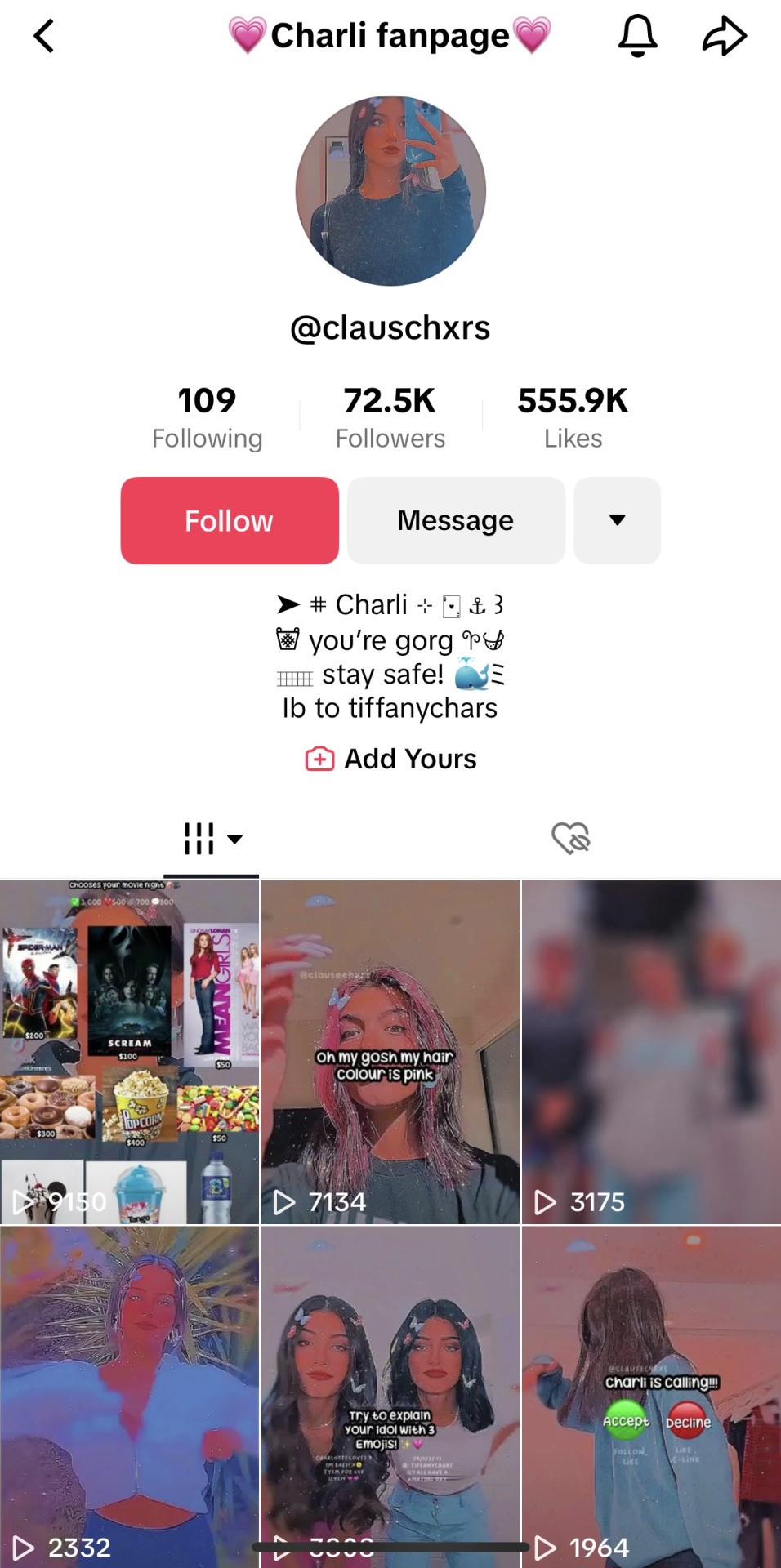
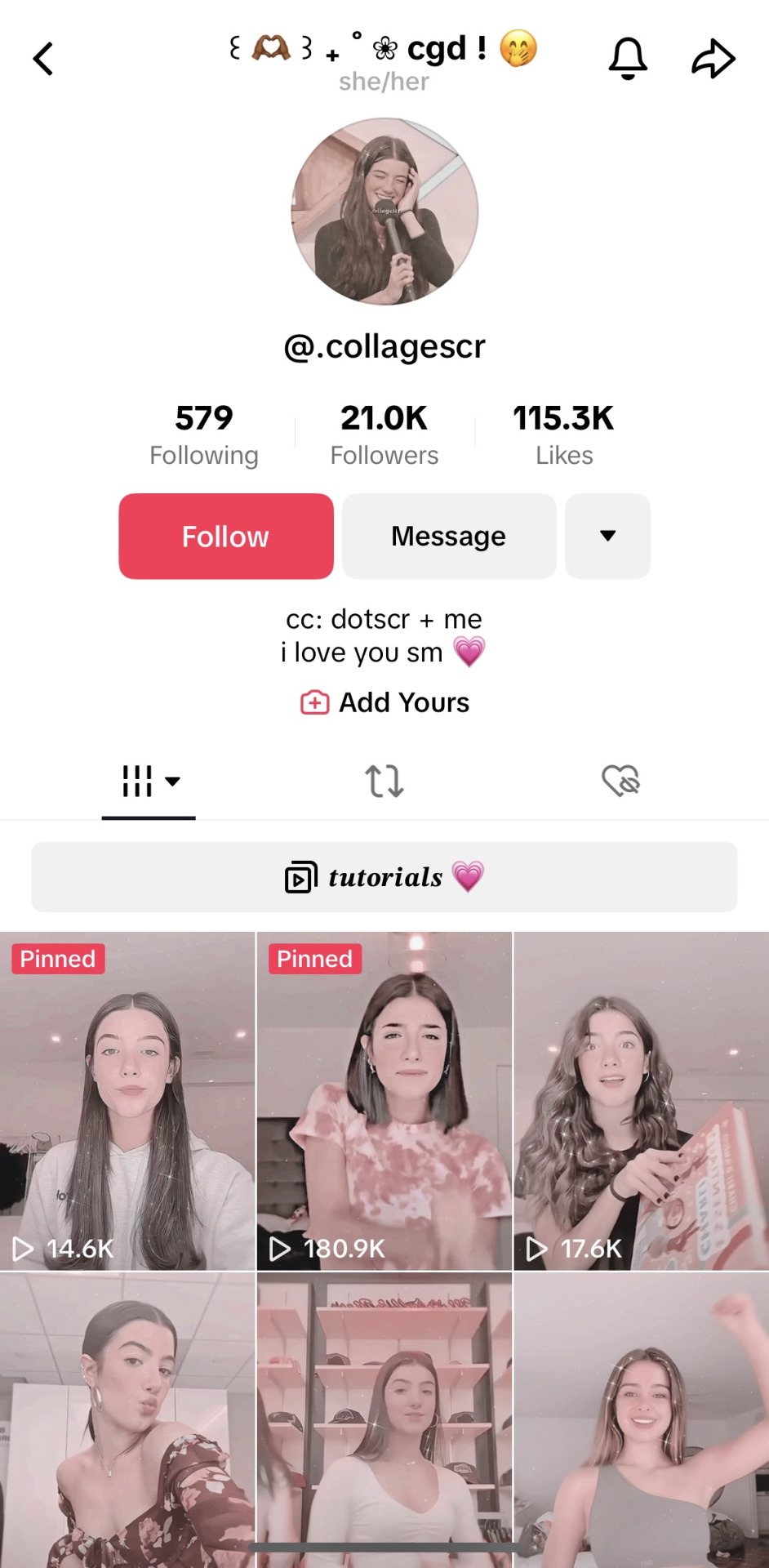
Photos From pages @clauschxrs and @.collagescr
Shown above are images of fan accounts for Charli and a video of a fan “doing her makeup like Charli D'Amelio.” There are thousands of accounts that have the entire purpose of editing clips of Charli and reposting her work. The users behind these accounts spend much time going through Charli’s digital footprint and analyzing or picking a part of their favorite parts. This obsession is concerning, and it is evident in the hoards of TikTok users who idolize and put Charli on a pedestal. The screenshot of the Charli D'Amelio makeup tutorial shows that her appearance influences her fan base to alter their appearances to look more similar.
A second feature on the TikTok app that holds evidence of the unprompted sexualization of the TikTok star is the “search” feature. This feature appears on the top of the celebrity video and shows the public the most common search that users make when watching the video. For example, someone could post a video of them cooking penne pasta, and the suggested search could be “penne pasta recipe.” In the recent month Charli posted a video of her playing an instrument in bed. She was fully clothed and sitting up criss-cross applesauce. The “search” for the video was “Charli D'Amelio arching her back”.
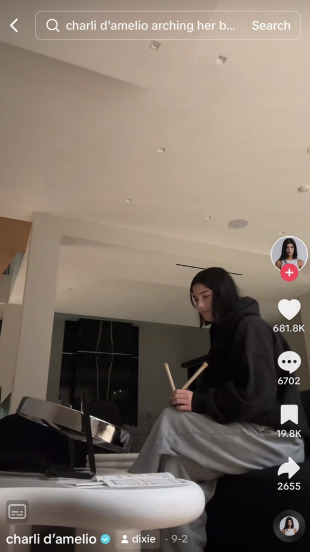
Photo from a Charli D'Amelio TikTok where the search bar says "Charli D'Amelio Arching her back"
This is a perfect example of how the user has been sexualized by the public. There was nothing sexual about Charli’s video. Her back was not arched, and the point of the video was to demonstrate her musical abilities with that specific instrument. Yet, the public took her location, a bed, and misconstrued a non-sexual observation into the young female influencer being inherently sexualized. The meaning that the “search bar” element holds is alarming. Out of 11.1 million viewers on this video, the most common search was this predatory thought.
Influencers have this name for a reason, they do just that, influence. On TikTok or any other social media platform, they use the app to gain and curate a following. This is exemplified by the most popular TikTokers in America like Charli D'Amelio, who has become an idol to many young girls. However, as we can see in multiple facets of TikTok that she and young girls alike are receiving unwarranted, misogynistic, and sexualizing attention. This creates a damaging notion in impressionable young viewers' minds that these comments are permissible and to strive toward an unrealistic beauty standard.
SOURCES
Cgd (@.collagescr). 2023. TikTok, December 8, 2023. https://www.tiktok.com/@.collagescr?_t=8i6H2HnPoHG&_r=1
D'Amelio, Charli (@charlidamelio). 2023. TikTok, September 2, 2023. https://www.tiktok.com/t/ZPRvEd7wc/
Fanpage, Charli (@clauschxrs). 2023. TikTok, December 8, 2023. https://www.tiktok.com/@clauschxrs?_t=8i6GywhtouF&_r=1
George, Cassidy. “How Charli D'Amelio Became the Face of Tiktok.” The New Yorker, September 5, 2020. https://www.newyorker.com/culture/cultural-comment/how-charli-damelio-became-the-face-of-tiktok#:~:text=Someone%20like%20Charli%2C%20a%20girl,wealth%2C%20TikTok%20culture%20reveres%20ordinariness
(@helikestowearabodysuit). 2023. TikTok, December 2, 2022. https://www.tiktok.com/t/ZPRvEpAqy/
Jake (@jake.wolff). 2019. TikTok, October 31, 2019. https://www.tiktok.com/t/ZPRvEnVTL/
Kate, Addison (@addisonkateeee). 2023. TikTok, July 10, 2023. https://www.tiktok.com/t/ZPRvEpdRH/
Kirk, Gwyn, and Margo Okazawa-Rey. “Bodies, Health, and Wellness.” Essay. In Gendered Lives Intersectional Perspectives, 185–202. New York: Oxford University Press, 2020. Vo, Linda Trinh. “Transnational Beauty Circuits: Asian American Women, Technology, and Circle Contact Lenses.” Essay. In Gendered Lives, 202–10. Oxford University Press, 2020.
#Charli#charli d'amelio#influencers#tiktok#Rian#Western culture#creepy people#unwarranted comments#search bar#Influencers make me want a life i can't have#I wish I was skinny like them
0 notes
Text
How Can We Combine These Concepts to See Their Effects?
Although these are all hypothetical characters, there is significant data that backs up the concept that TikTok of these topics affect young people’s minds through different lenses.
A young boy watches a video on TikTok where Andrew Tate says, “A woman can’t go around fucking people and pretend it's the same as a man running around fucking people. It’s absolutely not the same. A man can only cheat if he loves someone else. If I have a woman I truly love, and I go out and fuck, and I come back to her, and I don’t care about her (the girl he had intercourse with who is not his partner), and I only love my girl. That’s not cheating. That’s exercise. If she even talks to a dude, that's cheating because females are emotionally invested. ” (Rapid Hustlers, 2022). This young boy may think, “Oh, he has a good point. The comments all agree,” because he watched the whole video, more of these videos will appear. Being exposed to this content, he is being molded to always think, “I get that,” or “I agree.” He may begin to show aggressive behavior towards women as he grows up due to this (James, 2023). Perhaps a girl he’s dating accuses him of cheating, and he argues it isn’t because of the content he surrounds himself with. He begins to only think of women in gendered roles. Rather than having people in his life who may tell him otherwise, he only knows people who watch the same content (Shea 2023, 15:53-16:32). He’s stuck in an echo chamber of this sexist and misogynist idea that his TikTok created because of the way the algorithm works.
Tiktok from @tate..aikido
Perhaps that idea is too far out, and you may be thinking, “Well, that’s so extreme that never happens.” we can also take the idea more mildly.
This time, a boy or a girl watches multiple videos about video games. The first video is from a popular first-person shooter known as Call of Duty, where the people in the clip are making fun of a girl, and all of the guys are laughing (Zimmerman, 2023). The guy laughs alongside the video; he then begins to play the game, makes fun of other girls, or, more often, simply laughs and doesn’t stop it from happening (Intenta). The girl thinks the game is for guys. That she can’t play it. The guys don’t even want me to play. She thinks “first-person shooters are for guys.” Both people, in some way, think that these war games are for boys (Healey, 2016). Now that video game content is on their FYP. They see videos where attractive girls are playing games like Stardew Valley or Animal Crossing both games are often considered “cozy” and “girly” (Tonya, 2023). The girl thinks, “That’s a girl I could play that game.” Meanwhile, the guy thinks, “Hm, that attractive girl is playing that game; must mean it’s for girls.” While these people may not be thinking these directly, as they continue to watch more content fortifying this idea, their subconscious is being influenced by TikToks.

Tiktok from @cozysimespy with it's hastags that show how cozy games are related to girls often.
Maybe you can’t imagine this happening with a girl. No girl would watch this content that’s so sexist. Maybe you’re a girl who could not imagine watching Andrew Tate or you simply aren’t interested in gaming. However, the point is to show that extreme sexist content isn’t the only content that shows sexist values. Take this example.
A girl downloads TikTok and watches Charli D'Amelio lip-syncing to a video with a beauty filter on. She sees Charli as pretty, thin, and with facial features she could never have. She swipes and continues to watch more and more videos of girls with perfect skin from filters, where the comments have boys saying she’s pretty because of her looks. She begins to believe that she is doing something wrong; her skin has bumps, and she doesn’t know how to look better to get comments like that. She continues to scroll daily; she sees trends like the pigtail theory and thinks, maybe if I wear my hair like that, people will like me. Perhaps while watching, she comes across videos of “that girl,” a concept where girls engage in self-care and betterment but often incorporate a certain fashion style (Aesthetic, 2023). To fit into the “that girl” aesthetic, she buys products so that people will see her as “that girl.” Without realizing it, she’s fallen into acting and dressing in a gendered stereotype and seeing herself through a tailored misogynist lens, all from TikTok’s algorithm.
Tiktok from selfcareelovebyl showing the "That Girl" aesthetic
SOURCES
Adile (@misshoxha). Tiktok, November 9, 2023. https://www.tiktok.com/t/ZT8aT8Dyu/
𝐀𝐞𝐬𝐭𝐡𝐞𝐭𝐢𝐜 (@selfcareelovebyl). Tiktok, July 5, 2023. https://www.tiktok.com/@selfcareelovebyl/video/7252443187858509062?_r=1&_t=8i76HWHm8HW
Charli (@charlix_rares_). Tiktok, June 12, 2023. https://www.tiktok.com/t/ZT8mYbgdt/
“Gender Stereotypes and Discrimination in Gaming.” INTENTA, September 15, 2022. https://intenta.digital/perspectives/gaming-gender-stereotypes-discrimination/.
Healey, Gareth. “Proving Grounds: Performing Masculine Identities in Call of Duty: Black Ops.” Game Studies 16, no. 2 (December 2016). https://gamestudies.org/1602/articles/healey.
Ionescu, Claudiu Gabriel, and Monica Licu. “Are TikTok Algorithms Influencing Users’ Self-Perceived Identities and Personal Values? A Mini Review.” Social Sciences 12, no. 8 (2023): 465. https://doi.org/10.3390/socsci12080465.
James, Will. “Andrew Tate: A Case Study on the Effects of Online Influencers on Students’ Education.” Define the Line, February 20, 2023. https://www.mcgill.ca/definetheline/article/andrew-tate-case-study-effects-online-influencers-students-education.
Matt Shea, “The Dangerous Rise of Andrew Tate,” VICE, YouTube, Jan 13, 2023, documentary, 15:53-16:32, https://www.youtube.com/watch?v=Nj1JSlKzHtc&t=949s.
Rapid Hustlers (@tate..aikido). TikTok, May 24, 2022. https://www.tiktok.com/t/ZT8acrXNA/.
Tonya (@cozysimespy). TikTok, May 30, 2023. https://www.tiktok.com/t/ZT8mYFpY5/
Zimmerman, Jenna (@jenna_zimmerman). Tiktok, August 30, 2023. https://www.tiktok.com/@jenna_zimmerman/video/7273237915218562346?_r=1&_t=8i75HMv5Dpq
#Andrew Tate#Tiktok#Gamer#Gamergirl#Toxic#That girl#gender ideology#gender identity#algorithm#cozy gamer#COD
2 notes
·
View notes
Text
Thank You For Reading!
Overall as we conclude our posts, we hope that we can give insight as to how TikTok and its algorithm can mold or harm young impressionable minds. Through our research and textbook we have been able to see this effect through filter bubbles, trends, filters, influencers, and our various example TikToks. Hopefully as new trends come up, you can challenge what it represents and think about how they can inadvertently or subconsciously promote various values and beliefs. We encourage you to keep these ideas in mind next time as you scroll through not only TikTok but all social media platforms.
Nina Mak: “What is Tiktok?!” "TikTok’s Algorithm" “How Can We Combine These Concepts to See Their Effects?”
Ruby Hochman: “The Algorithm's Effect on Users”
Henry William Cook: “TikTok Trends and Their Influence on Young Minds”
Oona Clementine Berk: “How Filters Promote Western Beauty Standards”
Rian Bendtsen: "Charli D'Amelio: A Case Study”
0 notes